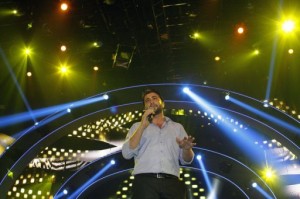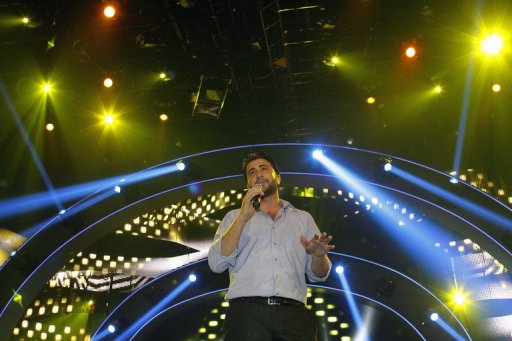
By Rana Moussaoui (AFP) – BEIRUT — Arab Idol contestant Abdel Karim Hamdan brought millions of television viewers to tears when he sang about the plight of his home town, the Syrian battered city of Aleppo.
“Aleppo, a flood of suffering, how much blood is shed in my country!” the 25-year-old sang in the Lebanon studio where the hugely popular show, modelled on British hit Pop Idol, is recorded.
“I wanted to sing the pain of my country,” Hamdan told AFP in between rehearsals at the pan-Arab channel MBC in Beirut.
“With a broken heart I cry for my land and the children who have become strangers in their own country,” he sang.
The lyrics, which he wrote, deeply affected his audience with their raw emotion and pain.
“That’s the voice we want to hear in the Arab world, not the sound of cannons!” exclaimed Nancy Ajram, a star Arab singer and jury member, as Hamdan’s fellow Syrian competitor Farah broke into tears.
“I wanted to sing about a cause that affects the whole world,” said Hamdan, who studied opera singing at the Institute of Music in Homs in central Syria.
The passions unleashed by the conflict followed Hamdan to Arab Idol, and he has been accused both of being a supporter of the regime and of the uprising against it that began in March 2011.
He has reportedly even received death threats.
The young singer, with a neatly trimmed beard, said he has “nothing to do with politics” and wants to “sing for Syria and that’s all”.
His passion has won over the audience, which welcomes his every performance with loud chants of “Syria! Syria!”
Far from the media frenzy of Arab Idol, other young Syrian artists are also finding that Beirut is a place where they can exorcise some of the demons that have accompanied them from the conflict.
On the sidelines of the Lebanese BIPOD festival of contemporary dance, 11 Syrian choreographers presented projects showcasing the scars of war.
One such performance, “My brother, the war and me,” depicts a crawling dancer on stage, hands tied, facing shadows representing Syrian regime soldiers.
“The most important thing for me is to show the suffering of human beings,” choreographer Ayass Moqdad told AFP.
Moqdad, 32, took ballet classes in the Higher Institute of Performing Arts in Daraa, the so-called cradle of the Syrian uprising. He left his hometown for Belgium five months after it began.
“War drives us to create,” said another participant, Hussein Khodur, who still lives in Damascus and says he once danced on broken glass after a blast near his institute.
For most, it is difficult to distance themselves from a war that has changed their lives for ever.
Choreographer Mithqal Alzghair, 32, who studied at the Higher Institute for Dramatic Arts in Damascus, expresses his take on the conflict in an unusual work called “Between revolt and death.”
Two dancers suspended by cables tied to their waists perform a slow and silent mid-air dance. Suddenly the sound of gunfire echoes, followed by the voices of militants announcing the date of videos filmed on the ground.
The two dancers curl their bodies, hug each other and seconds later one falls heavily on the stage.
“I asked myself how dance, which involves the body, can evoke death, the inert bodies we see on television. This is my way to participate in what is happening in my country,” says the slender Alzghair, who is preparing for a masters degree at the National Choreographic Centre of Montpellier in France.
“What is beautiful is that despite the difficulties they want to produce something,” said Omar Rajeh, the Lebanese organiser of BIPOD. “It is very important that they be allowed to express themselves on stage.”
Other Syrian artists have picked up jobs as waiters in cafes in Beirut’s bustling Hamra district to make ends meet.
Some are using their talents to make a living, like Bassem El Sayyed who has been drawing charcoal portraits of pedestrians in Sidon, the largest city in southern Lebanon, for the past year.
“One portrait goes for $14. With that money I help my family back in Aleppo,” he says, smoking cigarette after cigarette.
“Drawing makes me forget that I am in exile.”




